As we age, the face is an area of the body that begins to show signs of aging first. The face begins to sag, lose volume, and appear wrinkled as aging sets in. Fortunately, some solutions can reverse these signs of aging, and in some cases allow you to look 10 to 15 years younger. The most common facial rejuvenation procedure is the facelift.
Table of Contents
What is a Facelift?
A facelift, or Rhytidectomy, is a cosmetic procedure done to raise and tighten saggy skin that is present in the neck, jawline, and jowls. The surgery brings out a natural look by rejuvenating skin, combatting gravity, and slowing down the aging process. These results are long-lasting and are designed to give you a more youthful and refreshed appearance.
To complete the overall facial rejuvenation process, the Rhytidectomy may need to be combined with other procedures such as the brow lift, upper/lower eyelid surgery, and neck lift.
Before and After Facelift Patient Photos
Deep Plane Facelift Before and After Patient 1:
This 43-year-old patient was bothered by sagging skin under her chin and loss of definition in her jawline. She had previously had non-surgical treatments to try to improve these areas but was disappointed with the results. She sought out a deep plane facelift and neck lift to eliminate the sagging under her chin and to produce a crisp jawline. She loves her results and is shown here at just ten days post-op, as she was returning home out of state.
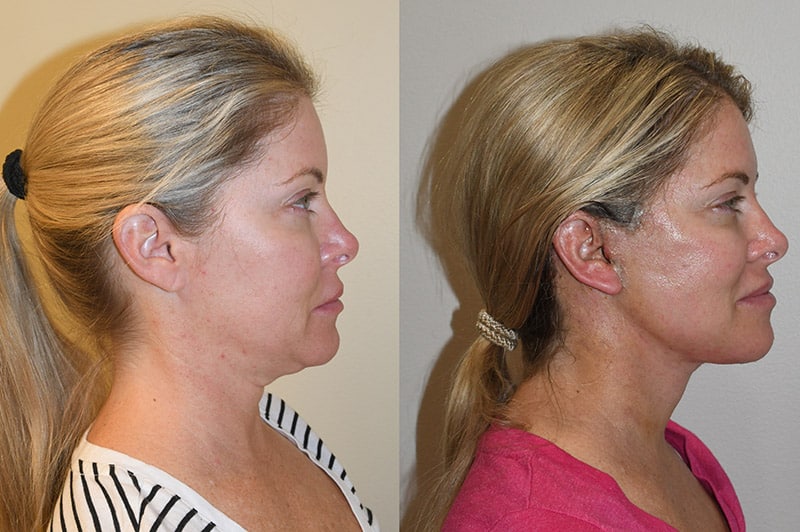
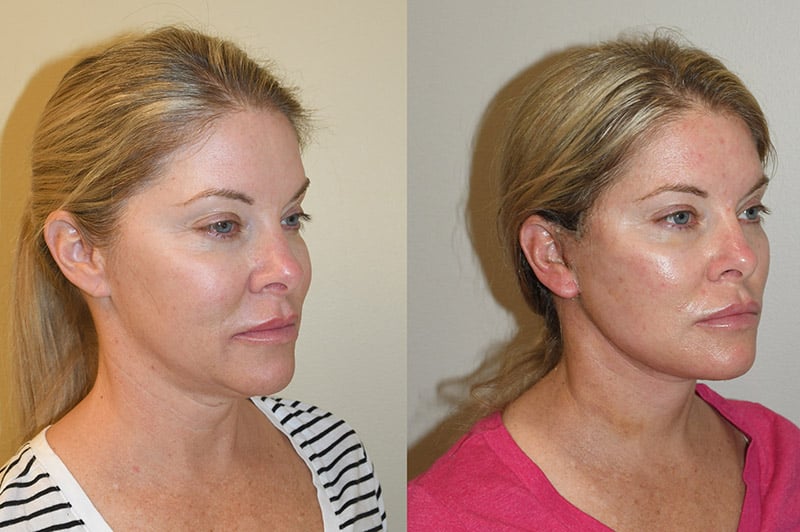
Deep Plane Facelift Before and After Patient 2:
This amazing patient was unhappy with how tired she looked with her heavy eyes. deep nasal labial folds, her visible jowls, and jawline. She also wanted to reduce the sagging in her neck. To address her concerns, Dr. Joseph Russell performed his deep plane facelifting technique, combined with a neck lift. To address her tired eyes, he also performed an upper blepharoplasty. She looks naturally refreshed and not fake or plastic.
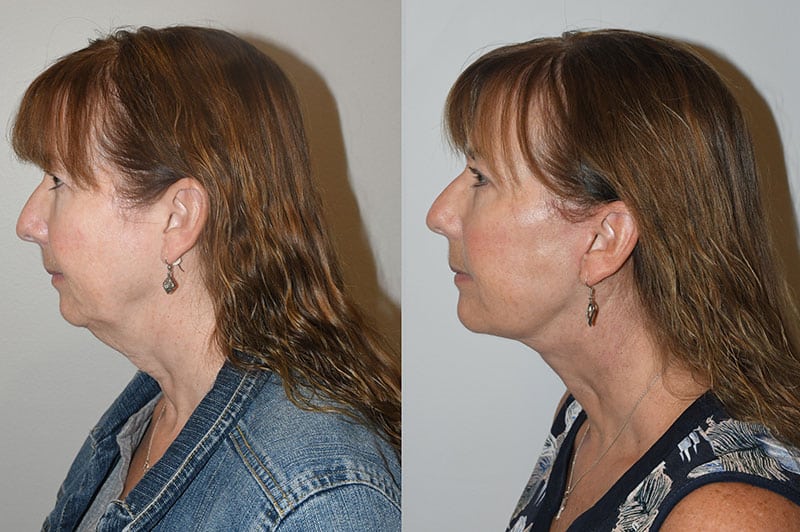
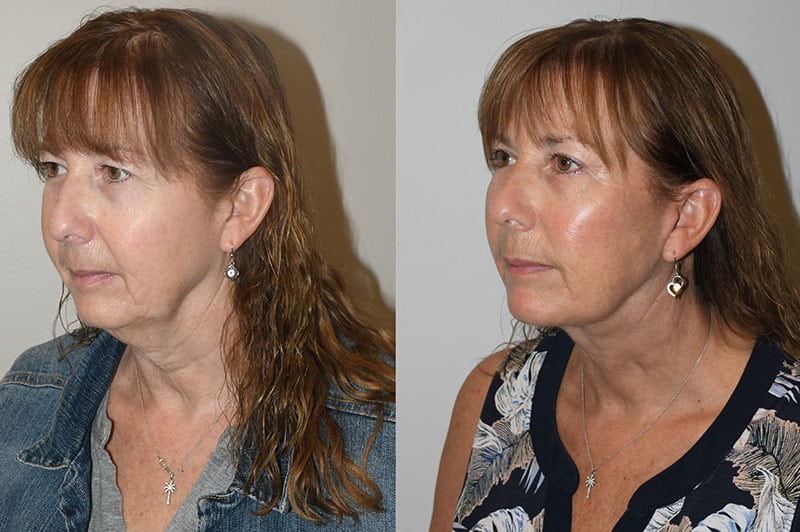
Deep Plane Facelift Before and After Patient 3:
This wonderful patient in her 70’s wanted to reduce the appearance of her deep jowls and her drooping cheeks and under her chin area. She felt it made her look older than she felt on the inside. To reverse these signs of aging, Dr. Joseph Russell performed a deep plane facelift combined with a neck lift. The deep plane lifts the muscles below the skin back to their normal, youthful position. Her after photo is 7 weeks out from surgery and she looks natural and refreshed.
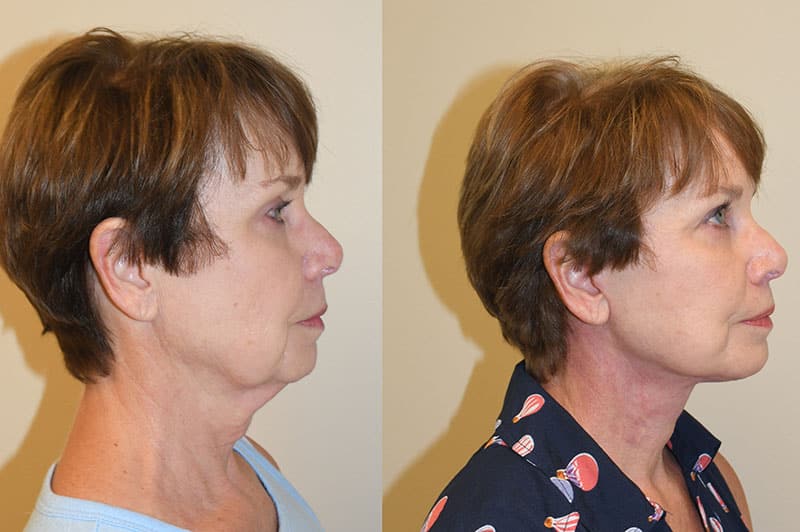
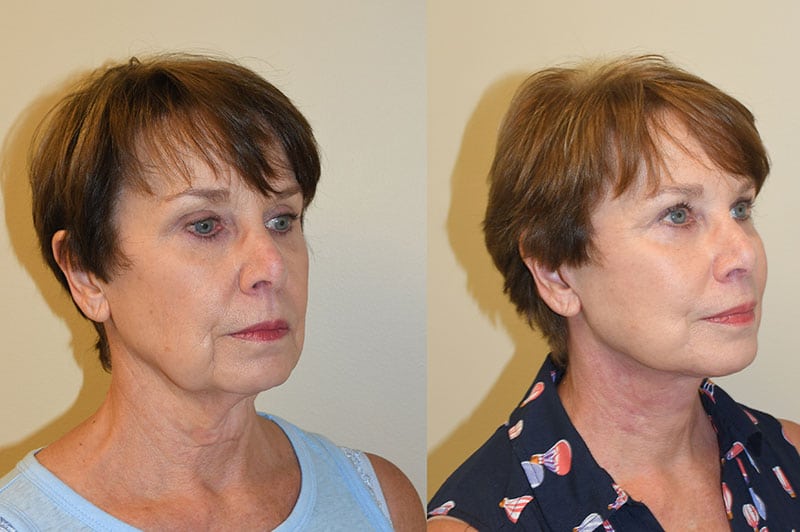
Deep Plane Facelift Before and After Patient 4:
This patient was bothered by the loose skin under her chin, deep cheek creases, and aged appearance around the eyes. She underwent a deep plane face and neck lift procedure performed by Dr. Russell to transform and restore her features. Because this technique lifts the drooping fat pads in the cheeks, her lower eyelids were also rejuvenated without any additional surgery.
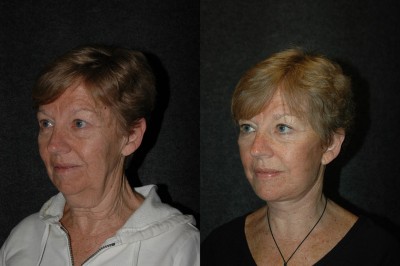
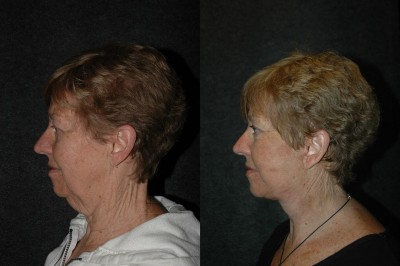
Deep Plane Facelift Before and After Patient 5:
Unhappy with her sagging jawline, neck, and brow, this patient opted for a deep plane facelift combined with a brow lift with Dr. Joseph Russell. Her after photos show that her cheeks look naturally lifted and she has a smooth and defined jawline. Her loose excess neck skin was removed, and a smooth surface was created. Doctor Russell also performed a brow lift to lift up her brows and she now looks awake and rejuvenated.
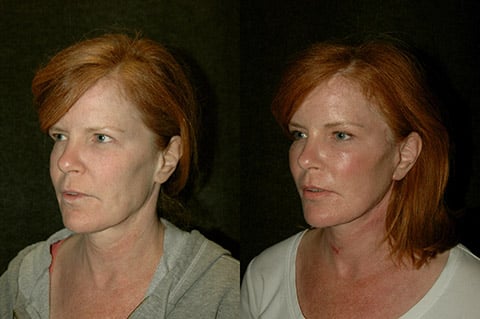
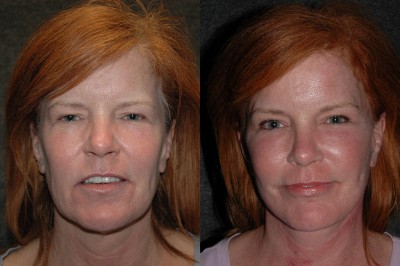
Deep Plane Facelift Before and After Patient 6:
This patient had concerns for her platysma bands, turkey neck, and jowls as well as with her upper eyelid area. Dr. Russell performed a facelift combined with a blepharoplasty to bring out a more natural and rested appearance.
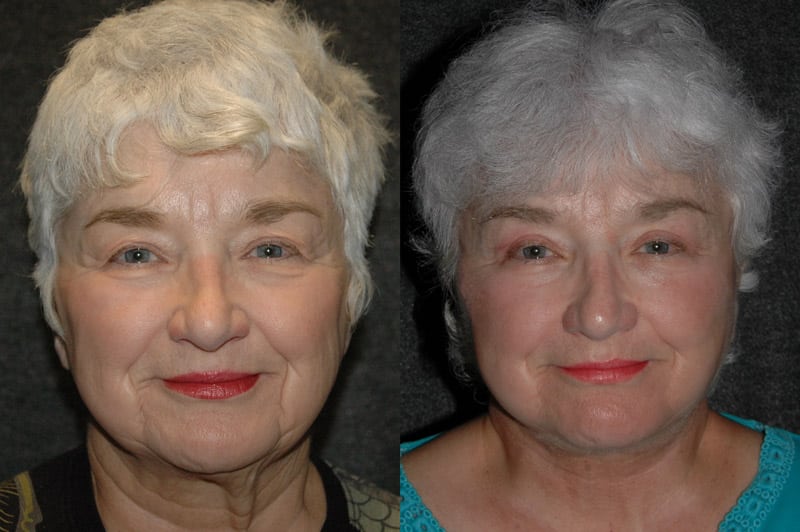
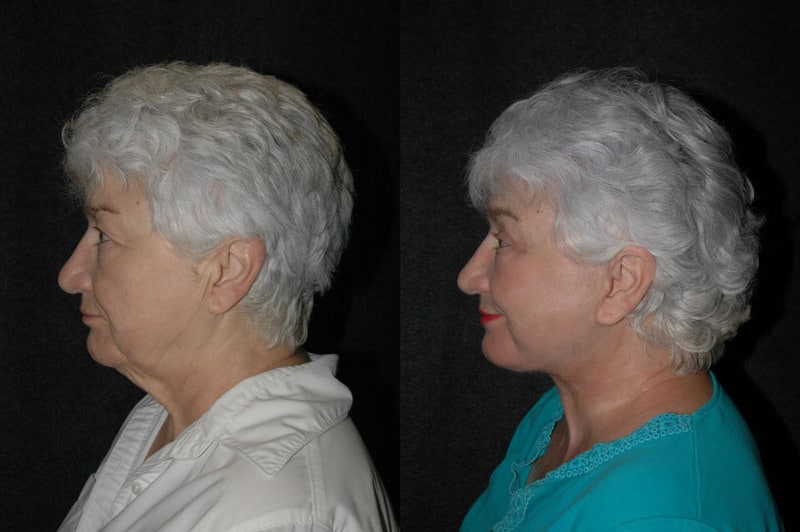
Deep Plane Facelift Before and After Patient 7:
This patient was unhappy with her lower face, jowls, and neck. Dr. Russell performed a facelift using the deep plane technique which repositions the drooping neck muscle and cheeks (jowl) without leaving the patient with a plastic or stretched skin appearance. Her after photos show a more youthful and natural result.
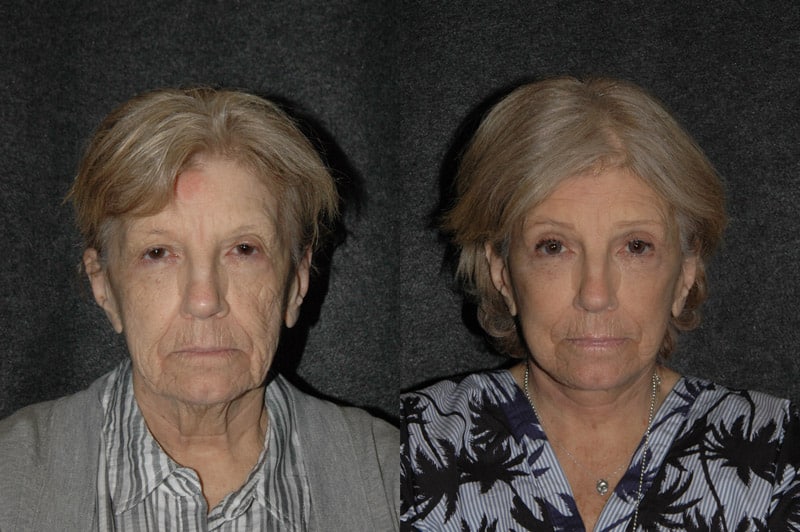
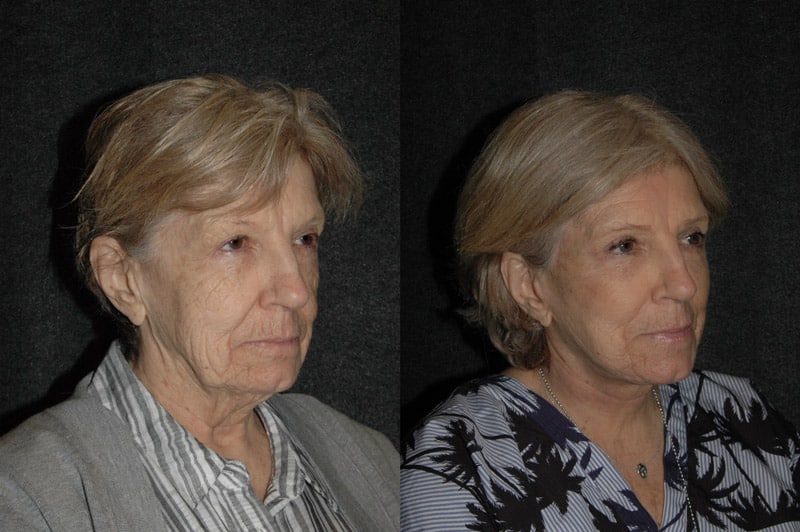
Deep Plane Facelift Before and After Patient 8:
This patient had a deep plane facelift procedure performed by Dr. Russell to lift her cheeks, jowls, and neckline. Minimal incision techniques were used to create a natural facial rejuvenation with no visible scarring.
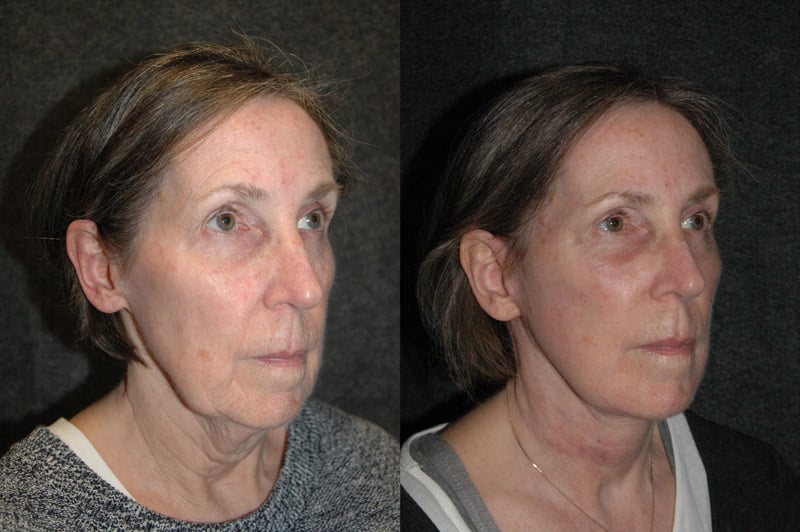
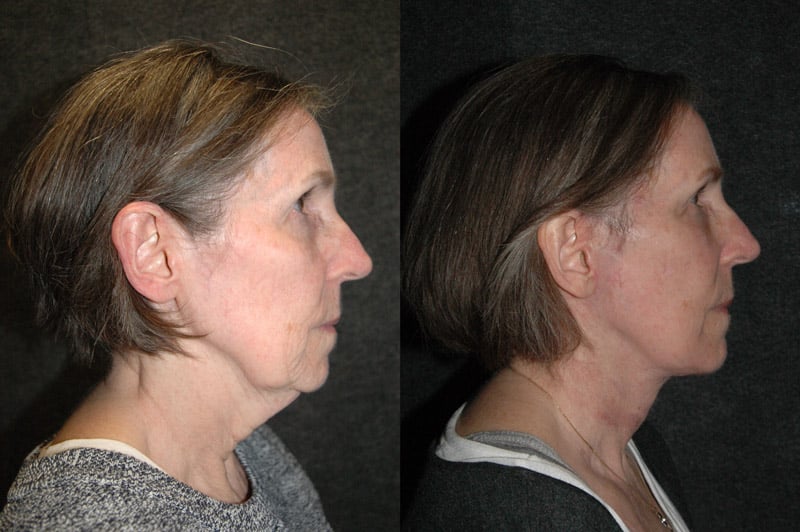
Deep Plane Facelift Before and After Patient 9:
This patient is in her mid-60s, and aging gracefully, but was bothered by jowling under the corners of her mouth and skin laxity in her neck. She had a deep plane facelift procedure performed by Dr. Russell to lift the drooping areas, create crisp jaw and necklines, and produce a completely natural, refreshed appearance.
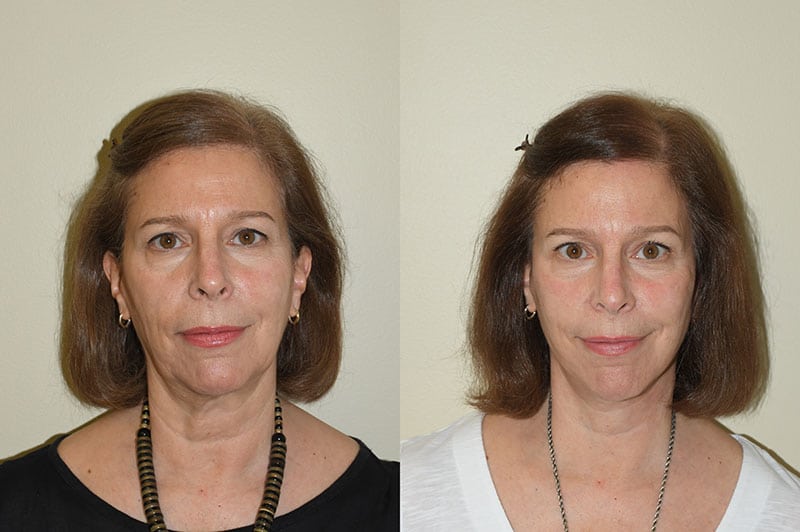
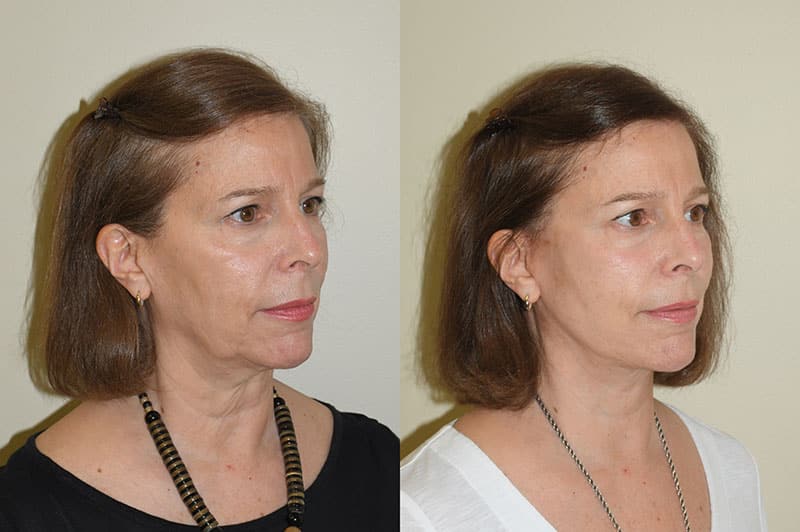
The Development of the Deep Plane Facelift
To understand the superiority of the deep plane facelift, one has to first understand the history of the development of facelifts. Up until the 1970s, all facelifts that were performed were skin-only facelifts: incisions were made around the ears, and the skin of the patient’s face was elevated all the way to the nose on each side; the skin was then pulled tight around the ears, the excess skin was trimmed, and the incisions were closed. The results of these facelifts looked great for the first year, and then the skin stretched out again, and in a year, the patient looked the same as he or she did before surgery.
As surgeons sought to find ways to produce longer-lasting results, the SMAS layer of the face was discovered. The SMAS is a fibrous and fatty tissue between the skin of the face and the muscles that produce facial expressions. By separating the SMAS from the skin, facelift surgeons achieved longer-lasting results. They tightened the SMAS layer through various techniques. The SMAS facelift and its many variants have become the facelift procedure that is performed for about 90% of patients today.
SMAS Facelift vs. Deep Plane Facelift
Unfortunately, the SMAS facelift has a major drawback: it does not lift the cheeks or reduce the heaviness of the nasolabial folds the folds of cheek (skin on either side of the nose).
The SMAS Facelift also often does not fully eliminate the hanging jowls that aging produces around the corners of the mouth. This is because there are two sets of ligaments that are not released during a standard SMAS facelift—the zygomatic cutaneous ligaments (cheekbone to skin ligaments) and the mandibulocutaneous ligaments (jawbone to skin ligaments). Because these ligaments are not released, the “lift” of the facelift is not transmitted at all to the cheek tissues, and partially transmitted to the jowls.
What Does Deep Plane Mean?
The “deep plane” refers to the space between the SMAS layer and the muscles of the face. In this revolutionary deep plane technique, the SMAS layer is not separated from the skin. Then the zygomatic cutaneous and mandibular cutaneous ligaments are released.
The layers of the face include:
- Skin
- Subcutaneous Fat
- SMAS layer
- Facial Muscles
- The lining of the Facial Bones
- Facial Bones
The release of the ligaments is one of the most important components of a deep plane facelift—it allows the cheek fat to be resuspended to where it was in youth, and this simultaneously softens the nasolabial folds, reduces the hollowness under the eyes, and produces a smooth jaw and neckline.
Depending on the extent of neck drooping, the deep plane facelift may be combined with a platysmaplasty to tighten and eliminate neck bands. A hidden incision under the chin allows vertical cords and chin fat removal.
Deep Plane Facelifting Offers Improved Longevity
The deep plane facelift corrects deep nasolabial folds, sagging cheeks, and hanging jowls. This produces a completely natural, rejuvenated appearance, rather than the tight, overfilled look other facelifts often result in. Furthermore, patients who undergo a deep plane facelift are more than three times less likely to need a revision or “tuck-up” procedure. This is compared to patients who undergo a SMAS facelift (the rate is 3% for deep plane procedures and 11% for SMAS procedures).
Understanding the Risks of a Facelift
The facelift is by far one of the most well-known cosmetic procedures. People have been receiving Rhytidectomies for close to a century now. Over time, newer and more modern techniques allow for much safer operations with more satisfying results. However, since this is a surgical procedure, there is a small possibility that a complication may arise. While rare, should a complication arise, Dr. Russell will make every effort to resolve it.
Potential complications of a facelift include:
- Blood collection under the skin (hematoma)
- Fluid collection under the skin (seroma)
- Hypertrophic (enlarged) scars
- Infection
- Asymmetry
- Facial Weakness
Additional Facelift Procedure Information
Come get to know Dr. Russell at any one of his three Charleston, South Carolina locations (North Charleston, Mount Pleasant, and West Ashley) to learn more about face-lifting. During your visit, you can view the before & after photos of Dr. Russell’s previous patients and get to know his staff better. For additional information about facial procedures or if you want to schedule a consultation appointment with Dr. Russell, you can call the main center at (843)-576-3302.
What Does a Facelift Cost?
Every facelift is tailored to each patient’s individual anatomy and varies in time and effort required to achieve a flawless outcome. The cost of your procedure will be determined at your consultation based on an examination of your individual anatomy by Dr. Russell and your surgical goals. Our patient care coordinator will provide you with a quote for the cost of all aspects of the procedure (surgery, operating room, and anesthesia fees) at the conclusion of the consultation.
Frequently Asked Deep Plane Facelift Questions
How long does facelift surgery take?
On average, Dr. Russell performs deep plane facelift surgeries in 5 to 6 hours. However, the time it takes will vary depending on the patient, their surgical goals, and if additional procedures are performed at the same time.
Does a facelift procedure leave visible scarring?
Every surgical procedure involving incisions will leave scarring of some sort. However, because of Dr. Russell’s additional fellowship training, specializing in deep plane facelifts, the incisions are strategically placed in hidden areas such as creases, so that the visibility of scarring is minimized.
Will I have a painful recovery following my procedure?
Most patients are pleasantly surprised at how painless their recovery is. Many patients report having no pain at all. Nevertheless, there may be some mild discomfort or soreness, so all patients are provided pain medication to use after surgery if needed.
How long is my recovery going to take?
The day after the procedure, the dressing will be replaced with a soft wrap, to protect the sutures. Over the next 10 days, the skin sutures are removed, with the last being removed on the 10th day. To promote quicker healing, Dr. Russell prefers for his patients to take arnica montana, bromelain, and vitamin C one week before and two weeks after surgery. He provides the dosing instructions in his patients’ pre-operative packet. On average, most of our patients feel comfortable returning to work and social outings within 1 ½ – 2 weeks.
How is a Deep Plane Facelift Performed?
The surgery is performed in the operating room under deep sedation with local anesthesia (twilight anesthesia) rather than under general anesthesia. Incisions are hidden in the hairline and around the ears. Operating in the deep plane, the cheeks, jowls, and neck tissues are lifted to where they were in youth and secured in place with sutures. The excess skin is removed at the incision sites, and the incisions are closed with sutures. The patient’s face is then wrapped with a full-face soft cotton dressing that provides pressure to minimize bruising and swelling. It is an outpatient procedure, so the majority of patients go home the same day to begin recovery in the comfort of familiar surroundings.
Read more Facelift FAQs
- Facelift Surgery Understanding Rhytidectomy
- Causes of Facial Aging
- 10 Natural Ways to Have Beautiful And Youthful Facial Skin
- Top Charleston Facial Plastic Surgeon
Who is a Good Candidate for a Deep Plane Facelift?
Facelifts are performed most often on women and men in their 50’s and 60’s; however, it is not uncommon for patients in their 40’s or 70’s to undergo these procedures. The best candidates are active men and women with few or no health problems who are unsatisfied with the degree of aging they see in their faces. Patients must disclose any past surgical procedures (such as a prior facelift) and non-invasive treatments (such as Ulthera or Sculptra) that they have had on their faces, all of their medical conditions, medications that they take, and whether or not they use tobacco products so that Dr. Russell can develop the best evaluation and treatment plan for each patient.
Good Candidates Include:
- Women and men who are unsatisfied with their aging process or appearance.
- Patients who have realistic goals for their surgical outcomes.
- Patients in their early 40’s – mid 60’s.
- Patients who are in good physical health.
- Patients who are non-smokers.
It is always best to visit Dr. Russell for an in-person consultation to see if you are truly a candidate. However, for our out-of-town patients, a telephone consultation with a review of your photos can be arranged. Please contact our office to learn more.
Benefits for having a Consultation with Dr. Russell Include
- Learning about facial rejuvenation from a surgeon who graduated top of his medical class and was fellowship-trained by a top facelift surgeon.
- Receiving a personalized treatment plan based on your individual anatomy and surgical goals.
- Experiencing care from a surgeon and team who are committed to producing the best possible outcomes for every patient.
What Patients Are Saying
“Dr. Russell explained the procedure in detail. My recovery period was exactly as he prepared me for; no surprises at any point. No pain medications were necessary, not even Tylenol. I am very pleased with the results of my facelift.” – Ann, Charleston, SC
“After incredibly informative and helpful consultations with Dr. Russell, I knew that I had found the perfect surgeon: meticulous, so knowledgeable, and a perfectionist–with the most wonderful and caring personality imaginable. It is now 2 1/2 weeks after my procedure, and I know I could not have picked a more highly qualified or caring surgeon ANYWHERE. I am thrilled with what I can already see are completely natural results…” – Katherine, Charleston, SC
“Completely satisfied with the results of my facelift and eyes. Would not consider going to any other doctor. Highly recommend!!!” – Jane, Charleston, SC
Scheduling Your Facelift Consultation
The most important decision facing people considering a facelift is choosing the right facial plastic surgeon. Dr. Joseph Russell is dedicated to obtaining excellent surgical results for each of his patients and is known for his meticulous attention to every detail while performing surgery. He graduated Summa Cum Laude and first in his class from the University of South Carolina School of Medicine. He then completed his residency in head and neck surgery at the University of Texas Medical Branch.
To continue honing his skills, Dr. Russell then spent an additional year as a fellow under Dr. Andrew Jacono in New York. Dr. Jacono is world-renowned for his revolutionary deep plane facelift technique, which Dr. Russell studied closely. After completing that additional training, he returned home to Charleston and has continued providing world-class facial rejuvenation to residents of the Lowcountry, Southeast, and beyond.
If you are ready to restore your youthful vibrancy, Dr. Russell will likely help. Contact our office at (843) 576-3302 today to schedule a consultation.
